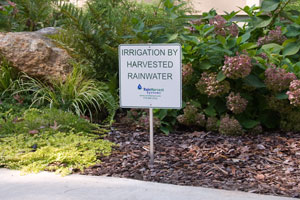Believe it or not a battle to stop a " rain tax " is going on just past the Orange Curtain to our direct North. A plan to charge as much as one dollar per gallon of storm water run off is being proposed by the county of Los Angeles. A parking lot of a Walmart exceeds 100,000 square feet, which yields 62,400 gallons per inch of rain. If they were not regulating their rainwater runoff to official guidelines that parking lot would generate $624,000.00 a year in fines based on an average rain year in Southern California.
It's as crazy as North Korea announcing recently that they were going to nuke us.
Apparently governments act by threatening as much force as you could imagine, say a nuke, or a dollar per gallon rain tax. Can education stop this aquaclypse?
Instead of threatening business killing taxes to penalize what is essentially poor civic engineering, why not spend money promoting changes in landscape designs that funnel the storm water back into the ground, instead of along to our oceans, full of cigarette butts, garbage and a toxic tea of urban runoff?
Educating landscape architects to work in coordination with civic engineers to totally rethink rainwater and storm water management combined with common sense funding would both spur an economic boom and help solve the problem of urban runoff and ground water depletion. By having construction companies cut bio-swales into streets and curbs in existing infrastructure, million of gallons of water will revert back where it belongs, which is in the ground. Making education about the benefits and capabilities of rainwater harvesting part of government spending will help make rain and grey water use widespread. I believe it should be even mandated in new construction.
If Los Angeles is able to pass any type of a rain tax other cities will follow their lead.
Any new tax, fine or operating cost placed on businesses will be passed on to consumers, or the businesses will cease to exist because they cannot pay the increased demands of the state. The government is saying, " now you got this nice company here, we gotta tax you for the water tax runs down our street when it rains. "
I mean, shouldn't they just follow Arizona's lead and get serious about rainwater harvesting?
Rainwater harvesting isn't just about rain barrels, its about the way cities manage storm water. The civic engineers created urban environments where water is not allowed to soak into the ground. The government agencies signed off on it and now they want to tax us for what is essentially ignorance about the way rainwater should be managed.
The system we have depletes the aquifers, which allows salt water from our nearby ocean to seep in, which makes the plants not grow, which makes food more expensive.
If only I could get people to watch this video. It would help to end The Cycle Of Insanity, and perhaps lead people to consider having a Rainwater System on their home.
The Cycle of Insanity: The Real Story of Water from
Surfrider Foundation on
Vimeo.
Supporting links;
http://www.altadenablog.com/2013/03/superviso.html
http://www.lacountycleanwater.org/









